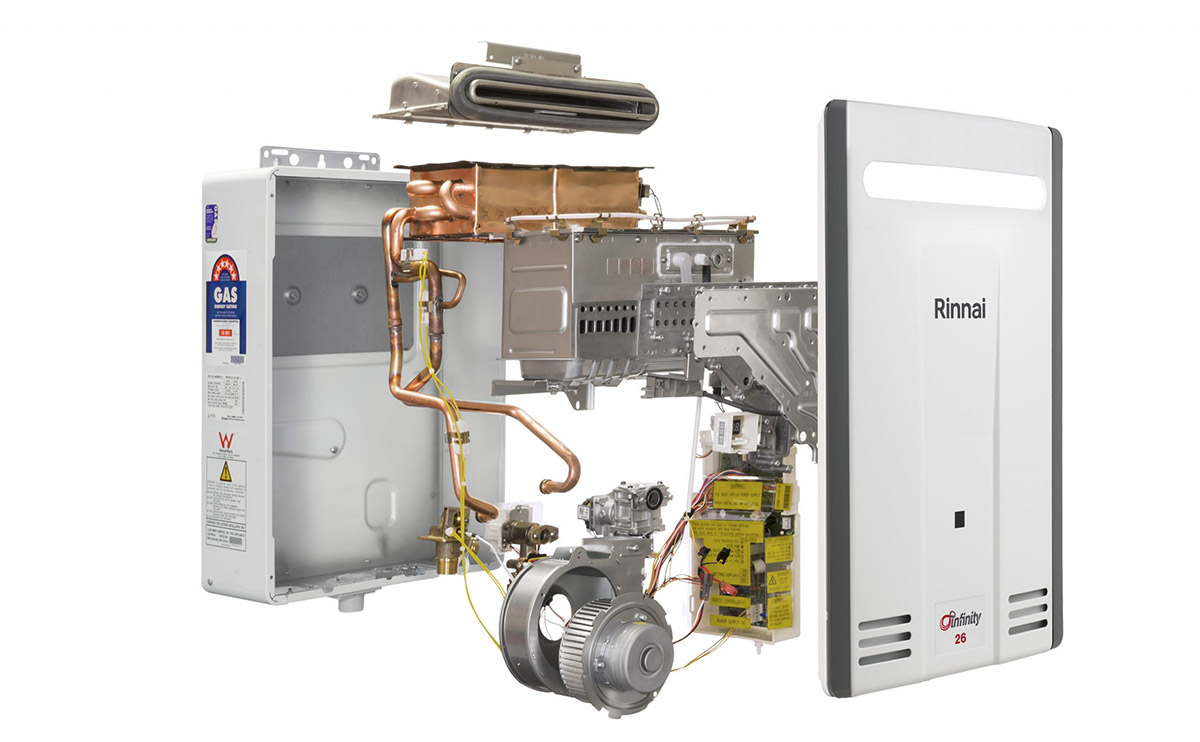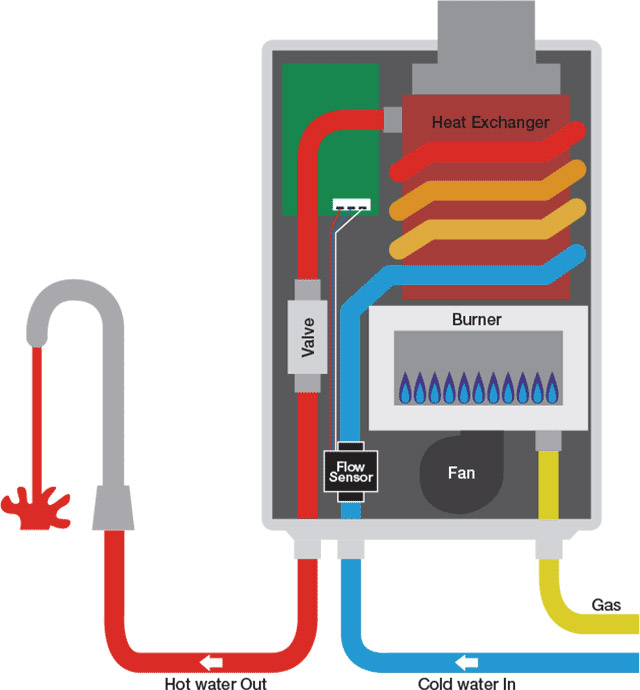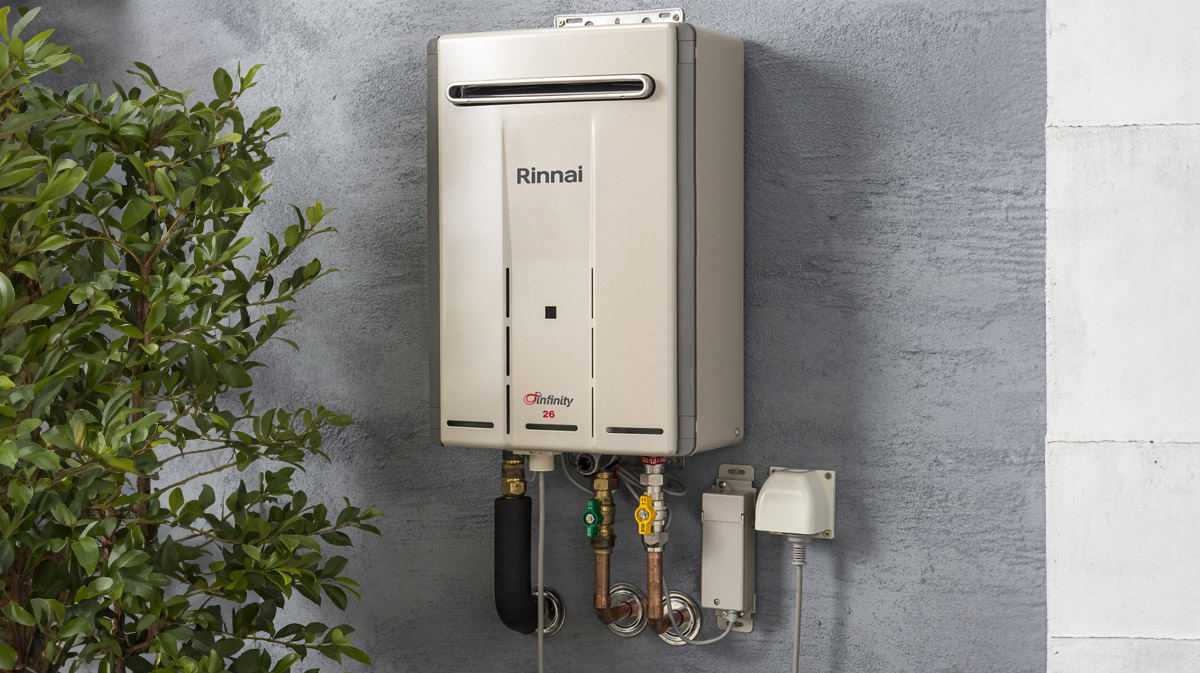Continuous flow hot water systems, also known as tankless or on-demand systems, revolutionise how we access hot water. Unlike traditional storage tanks that constantly heat and store a set amount of water, these innovative systems heat water instantly as it flows through the unit. This method ensures hot water is available whenever needed, without the standby energy losses associated with tank systems.
How Continuous Flow Hot Water Systems Work

Source: Rinnai Australia
Continuous flow hot water systems, also known as tankless systems, provide hot water on demand highly efficiently. Here’s a step-by-step explanation of how they work, described in layman’s terms:
- Starting the Process: Cold Water Inflow – The journey begins when you turn on a hot water tap in your home. This action triggers the movement of cold water through your plumbing and into the continuous flow system.
- Triggering the Heating Mechanism – As the cold water enters the unit, it activates a flow sensor. This sensor detects water movement and signals the system to heat the water.
- Activation of the Heat Source – Depending on your system type, a gas burner or an electric element is activated at this stage. For Gas Systems, a gas burner ignites, creating a flame that heats a heat exchanger. For Electric Systems, an electric element similar to those found in an electric oven heats up.
- Heating the Water – The cold water circulates through the heat exchanger (in gas systems) or past the electric element (in electric systems). As it does so, the heat transfers to the water, rapidly raising its temperature to the preset level.
- Delivering Hot Water to the Tap – The now hot water exits the system and travels through your home’s plumbing, arriving at your tap as steaming hot water, ready for use.
- Shutting Down – The water flow stops when you turn off the tap. Consequently, the flow sensor deactivates the heating element or burner, conserving energy only when hot water is needed.

Benefits of Continuous Flow Hot Water Systems
Continuous flow hot water systems offer several key advantages over traditional storage tank systems. Here are some of the primary benefits:
Unlimited Hot Water
One of the most significant benefits is the provision of an endless supply of hot water. Since the system heats water on demand, you’re less likely to run out of hot water during long showers or when multiple appliances are used simultaneously. This continuous availability is ideal for larger households or those with high hot water demands.
Energy Efficiency
These systems are highly energy-efficient. Unlike storage tanks, which need to maintain a constant temperature, continuous flow systems only heat water as it’s needed. This on-demand approach significantly reduces energy consumption and lowers energy bills. It also minimizes standby energy losses – the heat lost while water sits idle in a tank.
Space-Saving Design
Continuous flow systems are compact and take up much less space than traditional tank systems. This smaller footprint makes them ideal for smaller homes, apartments, or properties where space is at a premium. These hot water systems can be installed in more locations around the home, such as under a sink or closet, providing greater flexibility in home design and layout.
Lower Maintenance Requirements
With no tank to maintain, these systems generally require less maintenance than their tank-based counterparts. This translates to fewer worries about tank cleaning, sediment buildup, or the potential for tank leaks and associated water damage. The absence of a tank also means a reduced risk of corrosion and a longer lifespan for the system.
Drawbacks of Continuous Flow Hot Water Systems
While continuous-flow hot water systems offer many advantages, there are also potential downsides for informed decision-making. These drawbacks include:
Higher Initial Cost
One of the most notable drawbacks is the higher initial cost. Continuous flow systems typically have a higher purchase price than traditional tank-based systems. This upfront investment can be a significant factor for homeowners, especially those on a tight budget. While the long-term energy savings can offset this initial cost, the immediate financial outlay is undeniably higher.
Limited Flow Rate
Some models of continuous flow systems have limitations in their flow rate, which is the amount of hot water they can produce at a given time. This limitation means that during periods of high demand – like when running the dishwasher, washing machine, and shower simultaneously – the system might not provide enough hot water for all uses. This drawback can be a concern in larger households or where simultaneous hot water use is common.
Installation Requirements
Continuous flow systems may require specific gas or electrical connections that differ from those traditional tank systems use. This requirement can mean additional installation costs and complexity. For instance, a gas-powered continuous flow system might need a larger gas line or a new venting system. Similarly, electric models may require higher electrical capacity or special wiring. These installation requirements can add to the overall cost and complexity of switching to a continuous flow system.
Comparison of Continuous Flow Systems to Storage Tank Systems
When deciding between a continuous-flow hot water system and a traditional storage tank system, understanding the key differences in operation, efficiency, cost, and maintenance is essential.
Operation
- Continuous Flow Systems: They operate on an on-demand basis, heating water as needed. This means there’s no hot water storage, and the system activates only when a hot water tap is opened.
- Storage Tank Systems: These systems store a certain amount of hot water in a tank, constantly heating and maintaining it at a set temperature, ready for use.
Energy Efficiency
- Continuous Flow Systems: Generally, they are more energy-efficient because they eliminate the standby energy losses associated with keeping a tank of water hot at all times.
- Storage Tank Systems: They tend to lose heat over time (standby losses), requiring more energy to maintain the water temperature, leading to higher energy costs.
Cost
- Initial Cost: Continuous flow systems often have a higher initial purchase and installation cost than traditional tank systems.
- Operational Cost: However, the operational costs of continuous flow systems can be lower due to their higher energy efficiency.
Maintenance
- Continuous Flow Systems: They typically require less maintenance because there’s no tank to suffer from corrosion or sediment buildup.
- Storage Tank Systems: These systems may require more regular maintenance, including tank cleaning and anode rod inspection or replacement to combat corrosion.
Space Requirements
- Continuous Flow Systems: They are compact and save space, which is beneficial in smaller homes or apartments.
- Storage Tank Systems: These systems require more space for the tank, which can be a drawback in limited spaces.
Water Availability
- Continuous Flow Systems: They provide an endless hot water supply, ideal for continuous or simultaneous use.
- Storage Tank Systems: The amount of available hot water is limited to the tank’s capacity, which can be problematic during high-demand periods.
Lifespan
- Continuous Flow Systems: Typically, they have a longer lifespan than tank systems due to less corrosive damage and wear and tear.
- Storage Tank Systems: The lifespan is usually shorter because of the tank’s potential for corrosion and scaling.
Who Is a Good Fit for Continuous Flow Hot Water Systems?
Continuous flow hot water systems are not one-size-fits-all solutions. Certain households may benefit more from these systems depending on their specific needs and living situations. Here are some scenarios where a continuous flow system might be the ideal choice:
Small Homes and Apartments
Given their compact size, continuous flow systems are perfect for small homes, apartments, or tiny houses where space is at a premium. These systems can be installed in confined spaces like closets or under sinks, efficiently utilising limited space.
Single Occupants or Small Families
Households with fewer occupants typically have lower hot water demands. In such scenarios, a continuous flow system can efficiently meet the hot water needs without the excessive capacity and energy usage associated with larger tank systems.
Occasional Hot Water Use
If the hot water usage in your home is sporadic or occasional, a continuous flow system can be more advantageous. Since these systems heat water on demand, they avoid the energy wastage associated with keeping a tank of water hot for infrequent use.
Homes with Infrequent High Hot Water Demand
Homes with low daily hot water usage but occasionally have high demands (such as guest visits) might also find continuous flow systems beneficial. These systems can meet high demands when necessary without the constant energy usage of maintaining a full hot water tank.
Energy-Conscious Households
Continuous flow systems offer a more eco-friendly alternative for those prioritising energy efficiency and looking to reduce their carbon footprint. Their on-demand heating minimises energy wastage, aligning with a sustainable lifestyle.
Homes with Limited Water Resources
Continuous flow systems can reduce water usage in areas where water conservation is crucial. Unlike tank systems, which may require running water for some time to reach the desired temperature, tankless systems deliver hot water more immediately.



